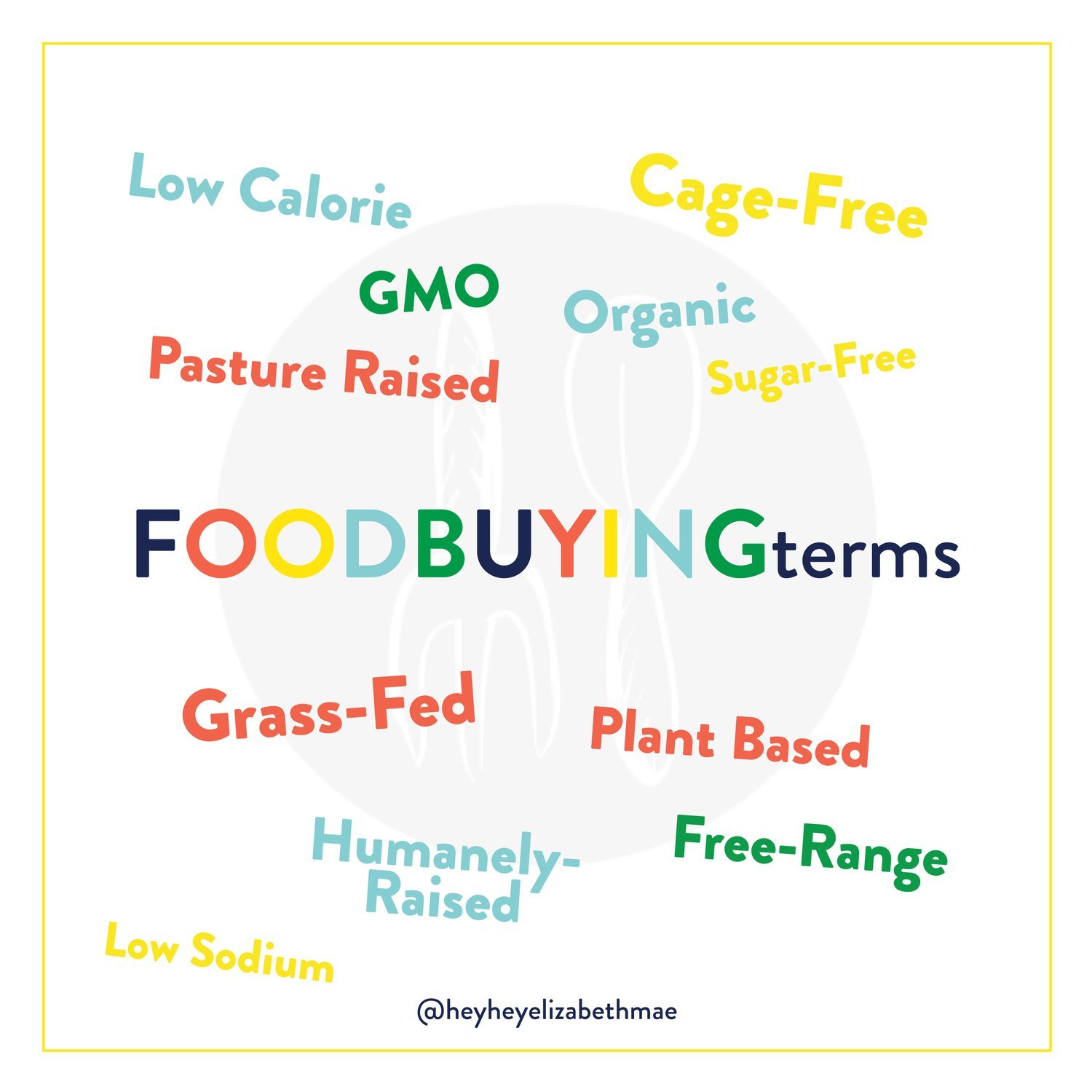Nutrition 102: Food Buying Terms
The next big food trend is hitting the grocery shelf and you haven’t even wrapped your head around the last set of food abbreviations or taglines?
I know that food buying and terms can all get a little confusing… GMO, organic, grass-fed, pasteurized, plant based, keto, etc. There are loads of terms - regulated and not - I want to clear it all up for you. This article is the second installment in my Nutrition 101 series and will be a great one to reference back to from time to time. You may not need it forever…after all, you’ll be a pro at food buying by the bottom of this page. Walk with me as we work toward reading our packages with a more clear understanding!
GMO
Genetically Modified Organism (GMO). GMO’s are foods that have been altered in some way that does not occur naturally, by way of biotechnology. In order to produce something that is genetically modified, one organism gets spliced with another and some genes are altered or removed so the plant has the desired outcome. For example, you could create herbicide resistance, resistance to frost and even lengthen the shelf life of foods. Common GMO crops include corn, soybeans, canola, squash, papaya, and salmon.
Organic
Organic describes foods that are certified to the standards of the National Organic Program, this is a legally regulated situation with a series of laws dictating plant and animal practices and production. Organic foods are required to be grown without synthetic fertilizers, pesticides, fungicides, or any food additives. Organic agriculture focuses on the health of the soil as well as the health of the animal or the plant. All organic foods can also be traced back from a finished product to the seed or the animal.
Grass-Fed*
Grass-fed indicates animals that have a natural diet consisting of grass and only grass - cattle, bison, lamb or goats eat only grass. You can also ask your local farmer if this animal has been grass-finished. Grass-finished means the animal ate grass for most, but not all of their life - there could have also been supplemental feed right before they head to the butcher, used to put weight on an animal, more quickly.
Cage-Free*
This has become another trendy term, unregulated, too. In many cases here hens aren’t housed in cages, but they are housed in huge barns. Which means these animals aren’t seeing the light of day, no access to sunshine, fresh bugs and the like. It’s a small, humane improvement, but doesn’t mean much.
Free-Range*
Free-range describes poultry that has has access to the outside but not required to go outside. This could simply mean that the chicken barn has open doors on it but the chickens don’t go outside or that they have a small porch to go onto.
Humanely Raised*
These are animals who are raised with a certain standard of care and have consistent access to food and clean water. This depicts practices all the way down to transporting, handling, and slaughtering the animal.
Pasture-Raised*
Poultry and pigs aren’t able to live on grass alone. Pasture-raised or pastured means animals get to navigate the fields and forage and feed off a variety of nutrients - bugs, grasses, etc. - throughout the pasture.
Low-sodium
Sodium is a mineral found in foods and can also be added to foods. Nutritionally, sodium helps balance normal fluid within the body. When it comes to minerals, we’re looking for balance - we don’t want to use iodized salt, as it contains only two minerals and can create imbalance in the body. Use least-processed Celtic sea salt or Redmond’s pink salt to keep your minerals and thus sodium in balance.
Sugar-free
Sugar-free means there is no added sugar within the product. This term des not include artificial sweeteners - in fact, these products are often sweetened with artificial sweeteners.
Plant Based
Plant based is most often used to denote avoiding foods that contain any type of animal product. Most labels have this to indicate it’s derived from plants or other non animal components. When it comes to plant based meats, you’ll often see lots of soy, chemicals, additives and thickeners.
Low calorie
Low calorie refers to a restriction of calories contained in the food. Foods can still be nutritionally disproportionate - high fat or high card, for example. Remember, a calorie is a unit of energy. Each type of macronutrient in food (fat, protein, or carbohydrate) provides energy to the body to be able to function. We need calories/energy in every cell of our body. Natural low-calorie foods are fruits and vegetables.
*These classifications can be regulated by third party companies that require farmers to meet certain standards that they have developed.
Now that we’ve covered these basic not so basic terms, I hope your shopping trip can go a smidge smoother! Read the labels and take your time - when in doubt (or because it’s yummy and a wonderful practice ), develop relationships with your local farmers!

